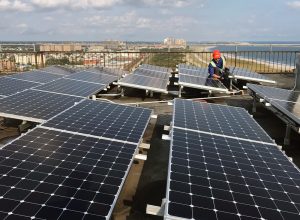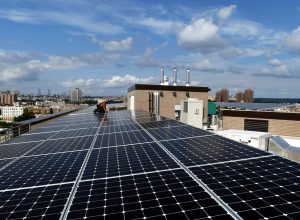Before the last week of October 2012, the notion of resiliency was largely an afterthought for the New York City real estate industry. Then Superstorm Sandy hit.
Lights went out. Basements and boiler rooms flooded. A lack of diesel fuel rendered emergency generators silent. Apartments were left without the basics: electricity, running water, elevators, heat, and general access to the outside world. Remembering lower Manhattan in a complete blackout still sends chills through the spine of the Oculus.
By Halloween, Sandy was gone but owners, managers, and tenants alike had already begun thinking about how to make their commercial and residential buildings resilient enough to stand up to the next Superstorm.
Resiliency makes your building stronger—and more profitable.
How do you make your building more resilient? With technologies like solar, cogeneration, and battery storage,* you can produce and store cleaner power at your buildings and provide site-level power security against utility outages. By carefully selecting, configuring, and operating the right set of technologies, a resilient power system can even pay for itself through demand reduction, peak shaving, and reduced supply cost. Bright Power’s Resilient Power Hub integrates solar, batteries, and cogeneration to provide:
- Energy cost savings
- Reliable, efficient onsite power generation
- Cleaner backup power
- Power security
- Reduced risk
A resilient building is a more profitable building. Being prepared for superstorms like Sandy is critical. But so is having clean and efficient systems to help your daily operation. Peak demand shaving? Yes. Cheaper electricity? Check. Safer and healthier residents? You got it!
How are real estate owners prioritizing resiliency?

Located steps from the Atlantic Ocean in Rockaway, New York, Arverne View was not originally built to withstand major storms like Sandy. L+M Development Partners acquired the property soon after Sandy, and worked with Bright Power to revitalize the community and develop a long-term resiliency and sustainability strategy.
The improvements implemented were focused on both maximizing utility savings and allowing the property to better withstand another Sandy-like event. These included installing new storm-proofed HVAC systems, and exterior wall insulation that both makes it easier and less costly to maintain desired indoor temperature and provided much-needed facade improvements. More recently, Bright Power worked with L+M to install 36 kW of battery storage and 36 kW of solar PV at the property to power onsite offices, emergency indoor and outdoor lighting, booster water pumps, and a community room in the event of an electric utility outage. On a regular basis, the solar and battery systems will provide peak demand shaving to reduce electric costs throughout the year.
Now, Arverne View is well-equipped to keep essential systems operating in the face of storms and grid outages while also keeping energy costs low.

Community Access is in the final stages of construction on their 126-unit affordable and supportive housing building on East 172nd in the Bronx. As with many affordable or supportive developments, it was important to build housing with low long-term operating costs. With a priority on operating efficiency and resiliency, Community Access worked with Bright Power to install a Resilient Power Hub (RPH) – a combination of a 53 kW solar PV system, an 18 kW battery storage system, and a 10 kW cogeneration unit.
The solar PV and cogeneration systems would create much-needed cost savings while the battery system, during an electric grid disruption, would run critical equipment to keep residents safe.
By installing the RPH, the project team was able to use a small emergency generator to meet code-required loads. Without the RPH, the building would have needed to install a larger, more costly backup generator. While a large generator would have powered critical equipment in the event of an electric grid disruption, such a system would have provided no operational savings to Community Access. With these technologies, Community Access will not only be able to avoid peak demand times, but in the event of a power outage, they will have backup electricity to power an elevator, water pumps, lighting to the corridors and exit stairwells, and the fire alarm. Importantly, the RPH will produce ongoing cost-savings so Community Access can provide resilient power that pays for itself over time, unlike the traditional generator.
“Managing energy consumption efficiently is better for our world, and reducing energy costs means more can be spent on programs and facilities for our tenants.”- Steve Coe, CEO of Community Access.
Protect your properties and residents.
Resiliency improvements arm buildings with consistent, efficient, and reliable power on a day-to-day basis. And they keep the building operating during an emergency. Technologies like the Resilient Power Hub can maintain your ROI and help you contribute to the fight against climate change through the use of renewable and cleaner energy systems.
Not sure where to start? Find out if your new development or existing building is a good fit for resiliency solutions by contacting one of our experts today!
—
*Solar harnesses the energy from the sun, producing site-level electricity. Battery storage captures and stores electricity for later use during peak demand pricing and grid outages. Cogeneration systems use natural gas to produce power onsite, generating electricity and pre-heated domestic hot water (a byproduct of electric generation). These systems power electrical systems such as common area lighting, elevators, pumps, and laundry and help reduce costs in areas where electricity rates are high.